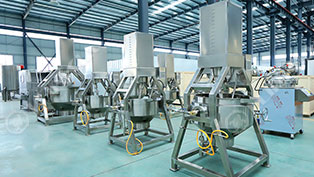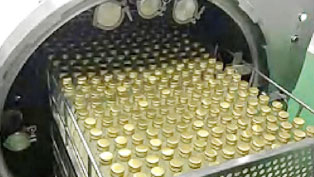Kettles are essential in food processing and commercial kitchens, providing efficient ways to cook, mix, and heat large volumes of food. LONKIA offers a range of industrial kettles, each designed for specific applications. This article explores the three primary types of kettles and their unique features to help you choose the right equipment for your needs.
1. Jacketed Kettles
Overview: Jacketed kettles are designed with a double-wall construction, where the outer layer (or "jacket") holds a heat transfer medium, such as steam or hot water, which surrounds the inner cooking pot. This setup provides even heating and precise temperature control.
Key Features:
- Temperature Precision: Jacketed kettles offer consistent heat, essential for temperature-sensitive cooking like sauces, stews, and jams.
- Large Capacity Options: They are ideal for high-volume production, accommodating large batches while ensuring uniform cooking.
- Safety and Efficiency: Equipped with advanced safety features and heat efficiency, jacketed kettles reduce cooking time while maintaining food quality.
- Applications: Jacketed kettles are commonly used for preparing soups, sauces, jams, and dairy products, making them a staple in many commercial kitchens.
2. Tilting Kettles
Overview: Tilting kettles are built with a pivoting mechanism, allowing users to tilt the kettle and pour contents directly. This design minimizes the need for heavy lifting and enables easy transfer of hot food, making it ideal for fast-paced kitchen environments.
Key Features:
- Ease of Use: The tilting function simplifies handling large quantities, reducing the physical strain on operators.
- Versatile Operation: Tilting kettles are suitable for cooking, simmering, and mixing a variety of dishes.
- Sturdy Construction: Typically made of stainless steel, tilting kettles are durable, corrosion-resistant, and easy to clean.
- Applications: Tilting kettles are perfect for soups, stews, sauces, and any liquid-based foods that need easy transfer or serving.
3. Electric Kettles
Overview: Electric kettles use built-in electric heating elements rather than an external heat source. These kettles provide fast heating and temperature control without the need for steam or gas, making them a convenient choice for kitchens without complex heating infrastructure.
Key Features:
- Efficient Heating: Electric kettles heat up quickly and are energy-efficient, reducing overall cooking time.
- Compact and Versatile: They come in various sizes, suitable for both small and medium-scale food processing.
- Independent Operation: With no need for external heating, electric kettles are convenient and flexible, often used in smaller food production setups.
- Applications: Electric kettles are ideal for sauces, gravies, soups, and many other prepared foods where quick, precise heating is needed.
Choosing the Right Kettle for Your Needs
Selecting the right kettle depends on production volume, food type, and kitchen setup. Jacketed kettles excel in high-capacity, temperature-sensitive cooking, while tilting kettles provide flexibility and ease in handling large batches. Electric kettles, on the other hand, are perfect for smaller operations needing fast, efficient heating.
Why Choose LONKIA for Your Kettle Needs?
At LONKIA, we offer high-quality, durable kettles designed for various applications, ensuring efficiency and reliability in your kitchen or production facility. Each kettle type is engineered to meet food safety standards and withstand the demands of busy commercial environments.
Contact Us for Expert Advice
Not sure which kettle is right for your business? Contact LONKIA today to discuss your requirements, get a personalized recommendation, and learn more about our range of high-quality kettles. Our team is ready to help you find the best solution for your kitchen.



